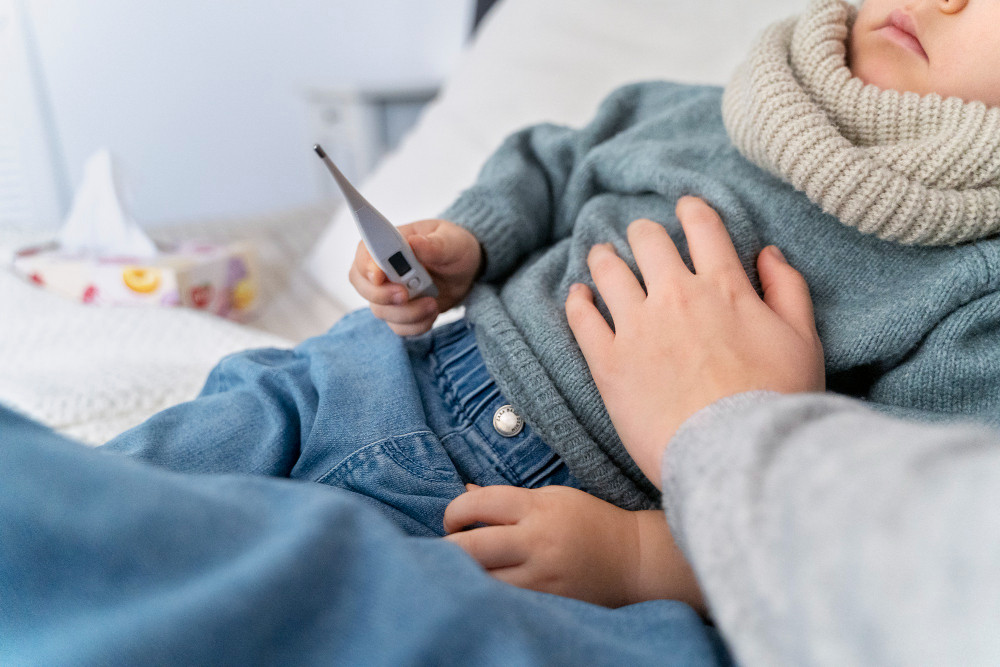Fever is not a disease but rather a symptom of an underlying medical condition. Fever indicates that your immune system is struggling with the disease.
However, fever is always a concern for parents, especially if it occurs in the middle of a Eid al-Fitr homecoming trip. Find out how to prevent children from getting a fever during the trip through the following discussion.
When is a child considered to have a fever?
A fever is generally defined as a body temperature that exceeds 37.5 to 38 degrees Celsius. The following symptoms are usually present with a fever:
- Warm to touch
- Irritable and less active
- Fast breathing
- Increased heartbeat
- Headache
- Chills
- Sweating
- Flushed skin
Causes of fever in children
Here are several causes of fever in children:
- Upper respiratory tract infection
- Flu
- Ear infection
- Roseola (a viral infection that causes a fever and rash)
- Tonsilitis (inflammation of the tonsils)
- Urinary tract infection
- Chickenpox
- Whooping cough
- Adverse reactions to immunizations
- Prolonged exposure to sunlight and high temperatures
How to prevent fever during homecoming
Fever in children during Eid al-Fitr homecoming can be due to prolonged sunlight exposure, using thick cloths, or bacterial or viral infection. To prevent fever in children during homecoming, you should:
1. Frequent handwashing
Handwashing does not directly prevent fever. However, handwashing is one of the important steps to prevent the spread of diseases, including fever, in children.
Children tend to touch their face, eyes, nose, and mouth frequently, which are common entry points for viruses and bacteria into the body. Washing hands with soap and clean running water can remove viruses and bacteria that may be on a child's hands, reducing the risk of infection and fever.
2. Teach children how to wash their hands properly
Proper handwashing can effectively remove germs and bacteria from children's hands. Teaching children how to wash their hands correctly is an essential step toward developing healthy living habits.
Here are the steps for proper handwashing:
- Wet hands with running water
- Apply soap and rub it between the fingers, under the nails, on the palms, backs of the hands, and wrists
- Scrub your hands for at least 20 seconds
- Rinse hands under running water until all soap is removed
- Dry your hands with a clean towel
Always carry hand sanitizer as a secondary option when clean water and soap are unavailable. Hand sanitizers with at least 60% alcohol are effective in eliminating germs.
3. Teach cough and sneeze etiquette
To prevent germs from spreading, teach cough and sneeze etiquette by covering the mouth or nose with the elbow when the child coughs or sneezes.
4. Avoid sharing cutlery
Provide special eating utensils for children, such as cups, spoons, plates, forks, and drinking bottles. Ensure that each child uses their own utensils without sharing to reduce the risk of spreading germs.
If your child has a fever, you can give them fever-reducing medicine. Seek emergency care at the hospital if:
- Fever that occurs in infants less than 3 months old
- Temperature that exceeds 39 degrees Celsius and does not decrease with fever-reducing medicine
- Fever lasts for more than 3 days
- There are signs of dehydration while the child has a fever
If you need medical advice or consultation, you can either visit a doctor or make use of the consultation features that are available in the Ai Care application by downloading the Ai Care application from the App Store or Play Store.
Looking for more information about pregnancy, breastfeeding, and the health of women and children? Click here!
- Sean Edbert Lim, MBBS
Krista O'Connell (2019). Everything You Need to Know About Fever. Available from: https://www.healthline.com/health/fever
KidsHealth (2022). Fever (High Temperature) In Kids. Available from: https://kidshealth.org/en/parents/fever.html
NHS Inform (2023). Fever in children. Available from: https://www.nhsinform.scot/illnesses-and-conditions/infections-and-poisoning/fever-in-children
CDC (2022). Keeping Hands Clean. Available from: https://www.cdc.gov/hygiene/personal-hygiene/hands.html
CDC (2022). Coughing and Sneezing. Available from: https://www.cdc.gov/hygiene/personal-hygiene/coughing-sneezing.html











